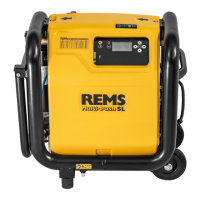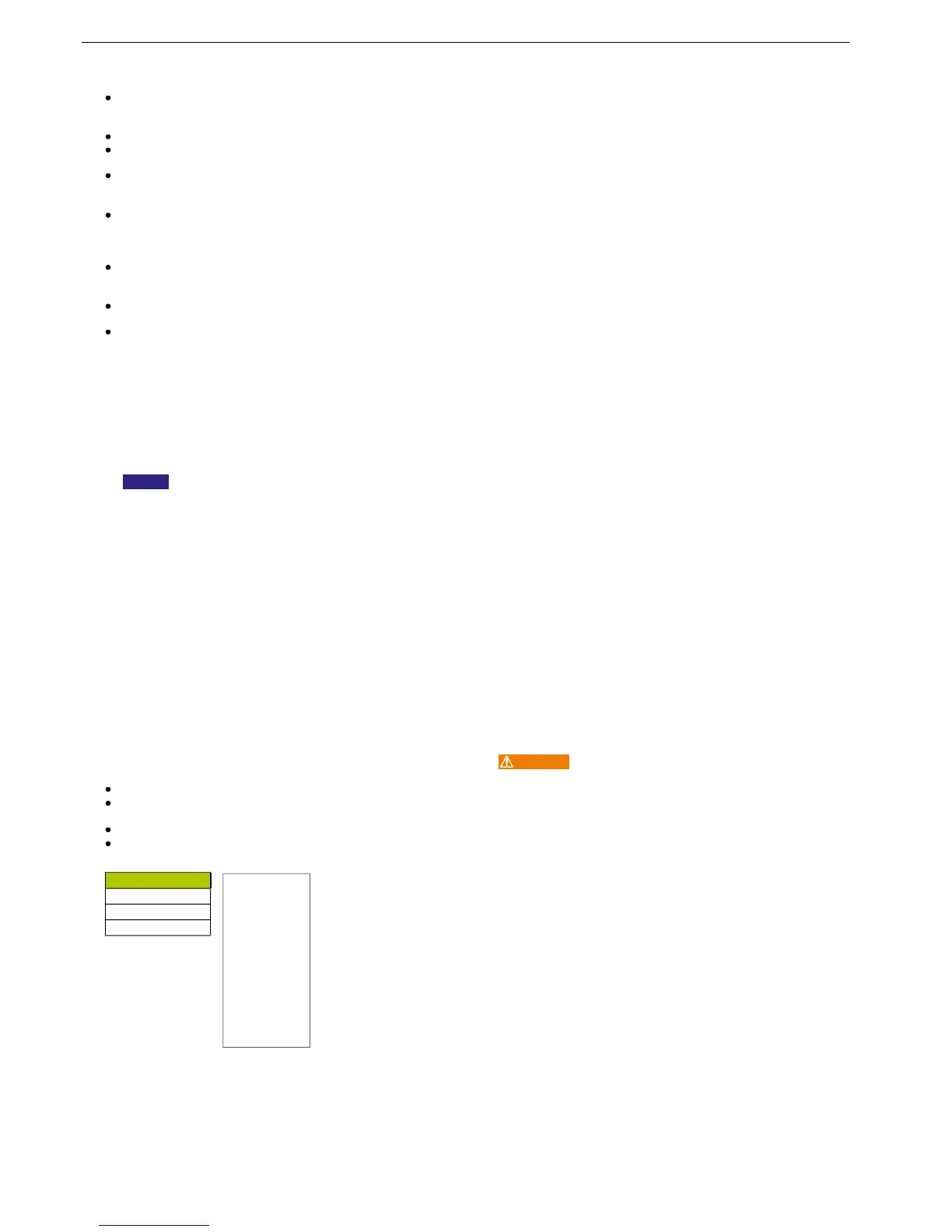to protect the drinking water against contamination. Never allow cleaner or
corrosion protection agent to fl ow though the pipes of REMS Multi-Push.
The cleaning and preservation procedure is as follows:
The heating system to be cleaned is fl ushed with a water/air mixture with
intermittent compressed air (see 3.1.2.). This reinforces the subsequent
cleaning. Pay attention to possible pressure limiting of the heating system!
Empty the heating system after fl ushing.
Connect the cleaning and preservation unit REMS V-Jet H (Fig. 7), as
Remove the locking ring from the cap of the 1 l bottle of REMS CleanH
cleaner for heating systems. Screw the bottle to the cleaning and preser-
vation unit REMS V-Jet H (Fig. 7).
Select program Ingredients \ Cleaning Heating. A drain must be opened at
the end of the heating system to be cleaned during the fi lling process. This
must stay open until the green coloured cleaning solution fl ows out from
The bottle may have to be changed to clean heating systems with > approx.
100 l. To do this, close the supply and drain and remove the bottle (21)
slowly so that excess pressure can escape.
The cleaning solution must be drained from the heating pipes again after
an application time of approx. 1 hour.
After cleaning, the heating system is refi lled with the addition of REMS
NoCor corrosion protection for preservation of heating systems (program
Ingredients \ Preservation Heating) until the blue coloured corrosion protec-
tion solution emerges The bottle is fi tted and changed as described above.
The corrosion protection solution then remains permanently in the heating
Attention: The respective national safety provisions, rules and regu-
lations valid for the application site as well as the regulations of the
hot water boiler manufacturer must be considered and observed.
● Flush/clean the REMS V-Jet H thoroughly wi
th clean water at the end of
Hoses used for cleaning/preservation should no longer be used for pressure
testing with water and for fl ushing drinking water pipes.
3.7 Compressed air pump program
The pressure is displayed and controlled to the reference test pressure (p refer)
selected on the screen in the range from 200 to 0 descending in hPa (mbar,
psi) and in the range from 0.2 to 8.0 ascending in MPa (bar, psi).
Program sequence ↑ ↓ (8):
1. Compressed air pump \ Enter
2. Check reference test pressure default (p refer) and change if necessary
3. The vessel is pumped up to t
eference test pressure (p refer).
4. Esc >> Start menu \ Memory Manager, data transfer >>
The pressure of a vessel that is already under pressure is specifi ed as p actual
after connecting the vessel.
The program can be aborted at any time with the Esc button (10). Then all the
valves open and the pressure is released. The pump-up is saved but “Cancel”
3.8 Memory Manager, data transfer, logging
Four functions are provided for memory management:
Display saved results of the fl ushing and testing programs
Print saved results of the fl ushing and test programs on a printer. Plug the
USB lead (Fig. 9 (45)) into the USB port (Fig. 2 (33)).
Delete saved results of the fl ushing and testing programs
Save results of the fl ushing and test programs on a USB stick. Plug in the
USB stick at the USB port (Fig. 2 (33)).
The results of the fl ushing and test programs are saved with date, time and log
number in the selected language and can be transferred to a USB stick or
printer (accessory part no. 115604) (neither of which is included in the scope
of supply) for documentation. Necessary additions to saved data, e.g. customer
name, project number, tester, are possible on external devices (e.g. PC, laptop,
tablet PC, smartphone). Paper roll, pack of 5, for printer (Art. No. 090015).
Insert the paper roll and charge the battery before using the printer (Fig. 9 (40)).
If the printer is charged without the paper roll inserted, the LED (41) fl ashes
repeatedly 3 times. Push back the paper compartment rail (42) to open the
paper roll compartment. Insert the paper roll so that its end is transported from
below. Close the paper compartment. Keep the button (43) pressed for manual
paper feed. Connect the charger (44) and USB lead (45) to the printer and
charge the printer. To print stored results of the fl ushing and test programs,
plug the USB lead (45) into the USB port (Fig. 2 (33)). After selecting the memory
manager, press Enter, the printer switches on automatically. Select the Display/
Print menu item, select the fi le no. Press Enter to print the data shown on the
screen. Press the the button (43) twice to switch off the pusher. The connection
to the USB line (45) or charger (44) must be disconnected. The following printer
functions are indicated with the LED (41).
LED fl ashes repeatedly once: printer ready for operation.
LED fl ashes repeatedly twice: overheating
LED fl ashes repeatedly 3 times: low paper
LED fl ashes repeatedly 4 times: unsu
.9 Operation of compressed air tools
Compressed air tools can be operated up to a max. air requirement of 230 Nl/min
can be operated directly from the compressed air vessel. The air pressure
supplied by the compressed air vessel can be checked on the compressed air
vessel pressure gauge (Fig. 4 (30)). Th
e compressor can be switched off at
any time with the compressor emergency stop button (Fig. 4 (29)).
wheel must be raised to set the pressure of compressed air tools (Fig. 4 (31)).
be read at the compressed air tools pressure gauge
Drain REMS Multi-Push, REMS V-Jet TW, REMS V-Jet H as well as all hoses
completely to avoid damage; store dry at ≥ 5°C.
Residue water from pressure
testing with water, fl ushing, disinfection, cleaning and preservation should be
removed with the connecting hose compressor/water connections (Fig. 8 (38))
This is connected to the compressed air tools connection on
one side (Fig. 4 (28)) and respectively to the fl ushing supply (Fig. 1 (14)) or the
pressure test with water supply on the other side (Fig. 1 (24)). See 3.9 for the
MS Peroxi Color, REMS CleanH and REMS NoCor against frost,
heat and direct sunlight. Keep containers tightly closed and store in a cool,
The water connections on the
device and the hoses should be sealed by caps
or plugs to prevent contamination.
Notwithstanding the maintenance described below, it is recommended to send
in the power tool to an authorised REMS contract customer service workshop
for inspection and periodic testing of electrical devices at least once a year. In
Germany, such periodic testing of electrical devices should be performed in
accordance with DIN VDE 0701-0702 and also prescribed for mobile electrical
equipment according to the accident prevention rules DGUV, regulation 3
“Electrical Systems and Equipment”. In addition, the respective national safety
provisions, rules and regulations valid for the application site must be considered
Pull out the mains plug before inspection!
Check hoses and seals for damage before every use. Replace damaged hoses
and seals. Keep all the hose connections clean.
Remove residue water from
fl ushing, disinfection, cleaning, preservation or from pressure testing with water
after every use with the connecting hose compressor/water connections (Fig.
Seal machine connections and hose ends with caps or plugs. Flush
the REMS V-Jet TW disinfection unit or REMS V-Jet H cleaning and preserva-
tion unit (Fig. 7), without bottle (Fig. 7 (21)), with fresh water after every use.
Keep all the hose connections clean. Open both condensation screw plugs
from time to time (Fig. 1 (34)) to drain condensation from the compressed air
tank (Fig. 1 (35)), especially necessary when working at low temperatures;
observe storage temperature for unit of ≥ 5°C (1.3).
Remove the protective hood for the following maintenance work. Loosen the
s of the protective hood (Fig. 1 (37)) for this. Empty the tank of the
condensation and particle fi lter
in the electronic fl ushing and
pressure testing unit with compressor regularly. The fi lter cartridge must
be cleaned and replaced if necessary. Clean the air fi lter of the compressor
Change the fi ne fi lter cartridge (Art. No. 043054) of the fi ne fi lter (Art. No.
to ensure that the date and time remain saved at all times, the button
cell (Lithium CR1220, 3 V) on the back of the operating panel (Fig. 1 (36))
should be changed about every two years. Loosen the 6 screws of the protec-
tive hood (Fig. 1 (37)) to do this, remove the protective hood. Then loosen the
4 screws of the operating panel and change the button cell on the back of the
Clean the machine regularly especially when it has not been in use for a long
time. Clean plastic parts (e.g. housing) only with REMS CleanM machine cleaner
(Art. No. 140119) or a mild soap and a damp cloth. Do not use household
cleaners. These often contain chemicals which can damage the plastic parts.
Never use petrol, turpentine, thinner or similar products for cleaning.

